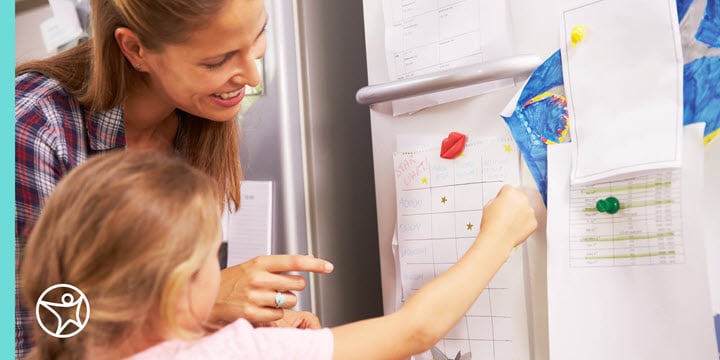10 Steps for Making Effective Rewards Systems for Kids In Virtual School
byChristopher E. Nelson
5 min to read
This post was originally published in November 2012, and has been updated for accuracy and comprehensiveness in October 2021.
As parents and as Connections Academy® Learning Coaches, we know that kids will push our buttons—and our limits—almost any way they can. Some kids may even rebel a bit more with Mom or Dad guiding their homeschool day.
Until they mature a bit, it’s not unusual for children to lack the motivation to “be good” just because it is expected. It might even be the result of a common child behavior change that all families might experience. But how can an adult teach a child to improve their behavior during online school classes and beyond without resorting to frequent arguing and punishment?
The answer may be a reward system. Because reward systems for kids at home provide positive reinforcement(opens in a new tab) for good conduct, this kind of behavior modification program can be a valuable tool to encourage children to change.
Here are 10 tips for developing an effective reward system for your k-12 virtual school students.
1. Tackle one behavior at a time
Don’t overwhelm your child with a lengthy list of faults—imagine how you’d feel if someone did that to you! Instead, focus on one top priority behavior change until that problem is resolved.
2. Consider what motivates your child
When planning appropriate reward systems for kids, think about your child’s personality and what’s most important to him or her. Chances are, it’s different for each of your children. Rewards needn’t be expensive; many parents use dollar store items or small privileges. Here are several low- or no-cost rewards your children may appreciate:
- Adding 15 or 30 minutes to “recess” time
- Earning an extra 15 or 30 minutes of gaming or TV time
- Staying up 15 or 30 minutes later
- Choosing which movie the family will watch
- Enjoying an edible treat, like a small candy or dessert
- Doing an enjoyable activity with a parent, like playing a game or taking a walk
- Visiting a local park
- Having a friend over to play when schoolwork is done
3. Involve your child in planning
Kids are more likely to comply with a virtual learning reward system they agree with and helped create, so before putting your plan in place, talk about it together. Ask for your child’s input about the goals, rules, and “prizes,” and try to incorporate suggestions that are reasonable.
4. Make sure your reward system is age-appropriate
Young children still struggling with their patience may have trouble waiting to collect multiple points or stickers before earning a reward. It’s best to structure programs for them to provide immediate gratification. Reserve points systems for older kids who can grasp the incentive for “saving up” for a higher-value reward.
- Download a Sample Reward System Template for Kids
- Download a Sample Reward System Template for Older Kids
5. Be clear and specific about the desired result
When you work with your homeschool child, state the desired behavior as a positive outcome.
- DON’T SAY: “Stop whining about starting your math problems.”
- REPLACE WITH: “Let’s begin math schoolwork today with just one reminder.”
6. Make the “rule” measurable
Specify the details of how your child earns the reward, such as start time, location, and steps involved in the task.
- To clean up a bedroom, the steps might be making the bed, putting dirty clothes in the hamper, and placing shoes in the closet.
- For schoolwork, you might list the number of problems to complete or the duration of a study session.
- When learning is involved, you may also want to add a quality measure, such as “complete spelling (math, etc.) assignment with two or fewer errors.”
Put the rules for earning virtual school rewards in writing so you can refer back to them.
7. Be consistent
Enforce the rules consistently, without “stretching” the boundaries or giving credit for almost hitting the goal. Always remember to give the reward when it’s earned! And no taking back virtual school rewards that have already been earned—that’s not fair!
8. Use positive feedback
Don’t rely on the “treat” or “prize” only; be sure to continue giving your child a pat on the back, hugs, and plenty of praise to reinforce their good behavior.
9. Keep trying
It can take 2 to 8 months to form a habit(opens in a new tab), so don’t be discouraged if you don’t see immediate results. Keep in mind that you may need to change the reward if your child becomes bored with it, but be sure to involve your child in choosing a new one of equal value.
10. Move on
The ultimate goal is to help your child become self-motivated to perform the desired task or behavior. When the positive change has been achieved, tell your child how proud you are of his or her success. After this, you have several options:
- Increase the level of challenge for the same behavior (30 minutes of studying instead of 15)
- Start tapering off on the reward
- Move on to another goal (just be sure to continue with the praise for this goal)
Learning to be self-motivated and well-behaved is an ongoing process for most school-age children. Remember that you may need to tweak your virtual incentives for students for more difficult tasks or goals. What works for one child may not work for his or her siblings, but once you understand the basic premise of the virtual learning reward system, it becomes easier to adapt it to each personality. With a bit of practice, the rewards system for kids is likely to become the most valuable gadget in your parenting toolkit!
Helping your child become a self-motivated learner is the start of a rewarding online school career. Check out eight more tips to help your middle school or high school student adopt good habits for successful online learning.



